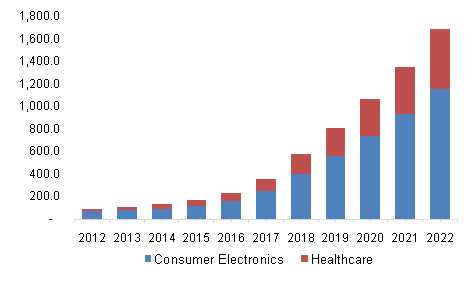JUN 2020| Report Format: Electronic (PDF)
The global quantum dot display market size is expected to reach USD 3.96 billion by 2022 according to a new report by Grand View Research, Inc.
Increasing awareness regarding energy-efficient displays is expected to boost global quantum dot display market growth. Surge in demand for advanced QLED powered TVs has propelled industry growth.
Advancements in quantum dot (QD) technology have made them useful for television manufacturers giving them a competitive edge in the industry. Creating better color with color tuning features has become a key selling point for display manufacturers. Moreover, adoption of QDs is expected to increase in smaller displays such as in smartphones and tablet devices owing to its capabilities in creating sharp crisp displays.
Cadmium-containing semiconductor-based QDs exhibit superior performance as compared to their cadmium-free counterparts. However, the toxic nature of such heavy metals has raised environmental concerns. Regulations in EU and Japan restrict the use of cadmium, compelling vendors to focus on the development of Cadmium Free Quantum Dots (CFQD). Manufacturers offering high-performance cadmium-free QDs in adequate volumes are expected to gain competitive advantage in the market moving forward.

Further key findings from the report suggest:
- QD based LEDs or QLEDs segment dominated the global quantum dot display industry accounting for over 45% of the market share in 2014. QD LED technology enables OEMs to manufacture UHD TVs with enhanced color gamut as compared to OLED UHD TVs, at reduced costs and improved energy-efficiency. In 2014, Samsung progressed from conventional UHD OLED TVs to QD-based LED 4K TVs to evade high development costs. Competitor TV companies such as Panasonic, LG,and Sharp have started developing UHD TVs incorporating QD technology, thereby driving the industry’s growth prospects.
- QDs are made up of binary compounds such as cadmium selenide, cadmium sulfide, cadmium telluride, and indium arsenide. However, toxicity of cadmium and global environmental regulations like the Restriction of Hazardous Substances (RoHS) Directive and the Toxic Substances Control Act have limited the amount of heavy metals such as cadmium, lead, and mercury that can be used in consumer electronic devices resulting in increased production of CFQD technology, and opened the doors for OEMs to use QDs in a variety of consumer electronic display devices.
- Consumer electronics segment dominates the QD display market accounting for over 70% of the revenue share owing to increasing use of this technology in TVs and mobile devices. In healthcare, such display technology is extensively used in activities such as cancer diagnosis, DNA labeling, cellular labeling, and biological imaging.
- North America dominated the global quantum dot display industry acquiring over 40% of the overall global revenue share in 2014. Key QD manufacturers in the industry are based in the U.S. owing to extensive R&D spending over advanced QD display technologies and high production capacities.
- Key industry participants include Dow Chemical, Nanoco Group, Nanosys, and Quantum Material Corporation. In addition to these, consumer electronic giants such as LG and Samsung are making joint efforts to develop and encourage the use of CFQD, with the latter already incorporating such advanced technology in its SUHD TV models.